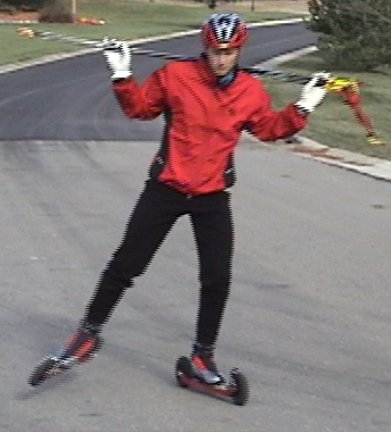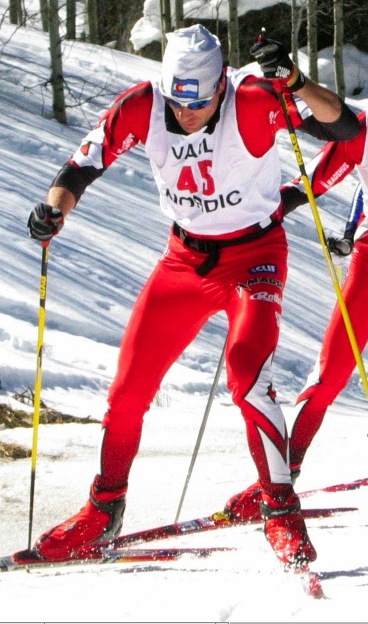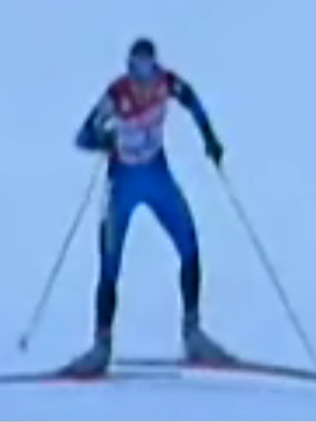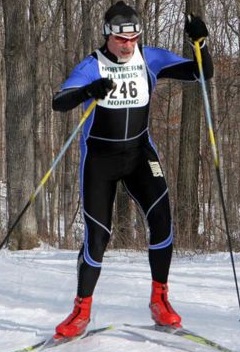| Master Skier Articles |
| About Lee |
| Purchasing DVDs/Videos |
| Lapham Peak SnowMaking |
| Silent Sports Magazine |
Various Enhancementsfor Silent Sport Articles
Enhancement to the January, 2007 Q&A.; In this issue I discussed the recent upright trend in skiing on the World Cup and how most citizen racers would benefit from such a style - especially those who are not in peak physical condition. Ironically we also discussed the posture changes needed for sprinting in the same issue. While sprinting the stance widens, the body becomes more crouched, turnover increases and the stroke becomes shorter. Note: Click on Master Skier Articles in the left sidebar for many additional sequences illustrating different aspects of technique - including more on upright skiing.
In this issue I discussed the recent upright trend in skiing on the World Cup and how most citizen racers would benefit from such a style - especially those who are not in peak physical condition. Ironically we also discussed the posture changes needed for sprinting in the same issue. While sprinting the stance widens, the body becomes more crouched, turnover increases and the stroke becomes shorter. Note: Click on Master Skier Articles in the left sidebar for many additional sequences illustrating different aspects of technique - including more on upright skiing.
Enhancement to the October, 2006 Q&A.; I wanted to include some rollerski drills with this month's Silent Sports article, but unfortunately ran out of space. However, I had just completed an article for The Master Skier on this very topic: See Skate Like a Bullet. Click on Master Skier Articles (sidebar on left) to access a summary of this article with the moving (video) illustrations.
I wanted to include some rollerski drills with this month's Silent Sports article, but unfortunately ran out of space. However, I had just completed an article for The Master Skier on this very topic: See Skate Like a Bullet. Click on Master Skier Articles (sidebar on left) to access a summary of this article with the moving (video) illustrations.Enhancement to the July, 2006 Q&A.;In this article I discussed the advantages that bigger wheels have in rolling over an uneven surface. While I mentioned the V-2 Aero rollerski, with its 6 inch tires, the main focus this month was on the latest rage in mountain biking, the 29er. (The "normal" mountain bike has 26 inch wheels.) There is no doubt that the 29er rolls over rocks and other obstacles easier than the 26er; it's simple physics. So the larger wheels produce a smoother and safer ride. And for me that was the major selling point. However there are many who feel the 29er, if equipped with the right equipment (mainly wheels), is faster all around and therefore the ideal racing bike. There have been "studies" which back up this claim, yet on the other hand there have also been "studies" that gave the opposite results. Therefore I've included some links so that you can make an intelligent decision on your own. However the best way is to test ride one. But for safety and comfort, for me it was a no-brainer; that's why I went to the 29er this year.Click here to view the Bontrager article. Click here to view "Cheating Legally with a 29er" Click here to view article on the 2005 national 24 hour champion who rode a 29er. Click here to view general 29er info. Click here to view general 29er info. Click here to view comparison of a 29er and 26er with identical setups . Enhancement to the June, 2006 Q&A.;Summary: In the June, 2006 issue of Silent Sports, I presented a short workout program for skiers of all ages, with a special emphasis on the older athlete. The following article is meant to enhance the June Q&A.; It is a reprint from the July, 2004 issue of Silent Sports. In this article I contrast the extremes of training, from an emphasis on short intervals to predominantly easy distance workouts. After that comparison I present a balanced training program (in bold print) that I've found to be much more effective than either of the above. Click here to view the entire article.Note: To see video clips of recent World Cup trends, click the Master Skier Articles Link on the sidebar This is a recent photo of Mike Trecker, one of our original "Banana Belt" junior skiers from the early 80s. While Mike never won a national championship, he developed a love of skiing which shaped his life-style. He was the assistant coach when the University of Colorado at Boulder won the NCAA cross country ski championship in 1991.
This is a recent photo of Mike Trecker, one of our original "Banana Belt" junior skiers from the early 80s. While Mike never won a national championship, he developed a love of skiing which shaped his life-style. He was the assistant coach when the University of Colorado at Boulder won the NCAA cross country ski championship in 1991.Mike is still active in coaching and his wife, Natalie Ward, has been one of the top women racers in the country. Now he has expanded his activities into announcing and writing. His other passion is bike racing. I included Mike here partly because I love this photo and also because he is a transplanted Midwesterner. While he now lives in Aspen, Colorado, he grew up in SE Wisconsin, so is familiar to many Silent Sports subscribers. But in addition, Mike's dad (Ed) had a great influence on cross country skiing in Wisconsin. He was the head of the DNR in the South Kettle and then moved "up." His influence and enthusiasm were huge factors in the growth of ski trails in SE Wisconsin. Unfortunately, Ed passed away at a fairly early age. The Trecker Lodge at Lapham Peak was named in honor of him. A lot of progress has happened since his passing and I think it's appropriate to remember Ed's contributions. To see the latest developments at Lapham Peak CLICK HERE. |
 In this issue I suggested that upright skating was more efficient when a skier gets tired on long steep climbs, as those found in the Birkie. The skier pictured on the left is one of the female World Cup leaders up a long climb at Val di Fiemme, Italy. That climb was so long and brutal, that all of the skiers adopted a very upright skating posture - just to survive. This was also true in the men's race.
In this issue I suggested that upright skating was more efficient when a skier gets tired on long steep climbs, as those found in the Birkie. The skier pictured on the left is one of the female World Cup leaders up a long climb at Val di Fiemme, Italy. That climb was so long and brutal, that all of the skiers adopted a very upright skating posture - just to survive. This was also true in the men's race.

 These two citizen racers (Mike and Jane Mandli) prove that "world class technique" is not out of the reach of the "normal" skier. This race (Illinois NIN at Kenosha, Wisconsin on 1/3/07) was held in temperatures hovering around 0ºF with wind gusts over 30 mph. Notice that both Mike and Jane, while skiing in an upright efficient style, are able to produce forward forces because of their complete weight transfer and forward lean. In upright skiing, forward lean is produced by flexion at the ankle. This is in sharp contrast to many average skiers who are very upright but "sit back" on their skis, so can produce little force in a forward direction. Photos by John Wrycza.
These two citizen racers (Mike and Jane Mandli) prove that "world class technique" is not out of the reach of the "normal" skier. This race (Illinois NIN at Kenosha, Wisconsin on 1/3/07) was held in temperatures hovering around 0ºF with wind gusts over 30 mph. Notice that both Mike and Jane, while skiing in an upright efficient style, are able to produce forward forces because of their complete weight transfer and forward lean. In upright skiing, forward lean is produced by flexion at the ankle. This is in sharp contrast to many average skiers who are very upright but "sit back" on their skis, so can produce little force in a forward direction. Photos by John Wrycza.